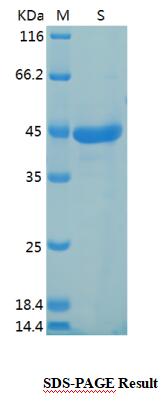Product Name :
CD112/NECTIN2 Recombinant Protein Swiss-Prot :
Q92692 Host :
E.coli Tag :
≥0.5mg/ml Amino acid Sequence :
QDVRVQVLPEVRGQLGGTVELPCHLLPPVPGLYISLVTWQRPDAPANHQNVAAFHPKMGPSFPSPKPGSERLSFVSAKQSTGQDTEAELQDATLALHGLTVEDEGNYTCEFATFPKGSVRGMTWLRVIAKPKNQAEAQKVTFSQDPTTVALCISKEGRPPARISWLSSLDWEAKETQVSGTLAGTVTVTSRFTLVPSGRADGVTVTCKVEHESFEEPALIPVTLSVRYPPEVSISGYDDNWYLGRTDATLSCDVRSNPEPTGYDWSTTSGTFPTSAVAQGSQLVIHAVDSLFNTTFVCTVTNAVGMGRAEQVIFVRETPNTAGAGATGG Restriction sites :
NdeI-XhoI Background :
Nectin-2, also known as CD112 and poliovirus receptor-related 2 (PVRL2), is a single-pass type I membrane glycoprotein ubiquitously expressed on various human tissues. It is a calcium independent cell adhesion molecule known to interact with several cell surface receptors, including DNAM-1 (CD226), LFA-1 (CD11a), Nectin-3 (CD113), TIGIT (VSTM3), and PVRIG (CD112R). It is one of the major constituents of adherens junctions, and therefore plays a central role in a number of cellular processes, including adhesion, migration, and proliferation. Within the immune system, Nectin-2 modulates immune cell signaling. Upon interaction with DNAM-1 expressed on T and NK cells, Nectin-2 stimulates proliferation and cytokine production. Upon interaction with PVRIG, Nectin-2 inhibits proliferation. Thus, Nectin-2 can be either a co-stimulator or a co-inhibitor of immune cell function depending on competitive receptor interactions. Nectin-2 also serves as an entry for certain mutant strains of herpes simplex virus and pseudorabies virus, and it is involved in cell to cell spreading of these viruses. Alternate transcriptional splice variants, encoding different isoforms, have been characterized. Soluble :
PBS, 4M Urea, PH7.4 Purification&Purity :
Transferred into competent cells and the supernatant was purified by NI column affinity chromatography and the purity is > 85% (by SDS-PAGE). Storage&Stability :
Store at 4°C short term. Aliquot and store at -20°C long term. Avoid freeze-thaw cycles. Expression vector :
pet-22b(+) BiowMW :
~36kDa Note :
For research use only, not for use in diagnostic procedure. concentration :
≥0.5mg/ml
CD112/NECTIN2 Recombinant Protein Swiss-Prot :
Q92692 Host :
E.coli Tag :
≥0.5mg/ml Amino acid Sequence :
QDVRVQVLPEVRGQLGGTVELPCHLLPPVPGLYISLVTWQRPDAPANHQNVAAFHPKMGPSFPSPKPGSERLSFVSAKQSTGQDTEAELQDATLALHGLTVEDEGNYTCEFATFPKGSVRGMTWLRVIAKPKNQAEAQKVTFSQDPTTVALCISKEGRPPARISWLSSLDWEAKETQVSGTLAGTVTVTSRFTLVPSGRADGVTVTCKVEHESFEEPALIPVTLSVRYPPEVSISGYDDNWYLGRTDATLSCDVRSNPEPTGYDWSTTSGTFPTSAVAQGSQLVIHAVDSLFNTTFVCTVTNAVGMGRAEQVIFVRETPNTAGAGATGG Restriction sites :
NdeI-XhoI Background :
Nectin-2, also known as CD112 and poliovirus receptor-related 2 (PVRL2), is a single-pass type I membrane glycoprotein ubiquitously expressed on various human tissues. It is a calcium independent cell adhesion molecule known to interact with several cell surface receptors, including DNAM-1 (CD226), LFA-1 (CD11a), Nectin-3 (CD113), TIGIT (VSTM3), and PVRIG (CD112R). It is one of the major constituents of adherens junctions, and therefore plays a central role in a number of cellular processes, including adhesion, migration, and proliferation. Within the immune system, Nectin-2 modulates immune cell signaling. Upon interaction with DNAM-1 expressed on T and NK cells, Nectin-2 stimulates proliferation and cytokine production. Upon interaction with PVRIG, Nectin-2 inhibits proliferation. Thus, Nectin-2 can be either a co-stimulator or a co-inhibitor of immune cell function depending on competitive receptor interactions. Nectin-2 also serves as an entry for certain mutant strains of herpes simplex virus and pseudorabies virus, and it is involved in cell to cell spreading of these viruses. Alternate transcriptional splice variants, encoding different isoforms, have been characterized. Soluble :
PBS, 4M Urea, PH7.4 Purification&Purity :
Transferred into competent cells and the supernatant was purified by NI column affinity chromatography and the purity is > 85% (by SDS-PAGE). Storage&Stability :
Store at 4°C short term. Aliquot and store at -20°C long term. Avoid freeze-thaw cycles. Expression vector :
pet-22b(+) BiowMW :
~36kDa Note :
For research use only, not for use in diagnostic procedure. concentration :
≥0.5mg/ml
Blocking peptide available as NCP0248P

 CD112/NECTIN2 Recombinant Protein
CD112/NECTIN2 Recombinant Protein 
 Datasheet
Datasheet COA
COA MSDS
MSDS SHIP
SHIP